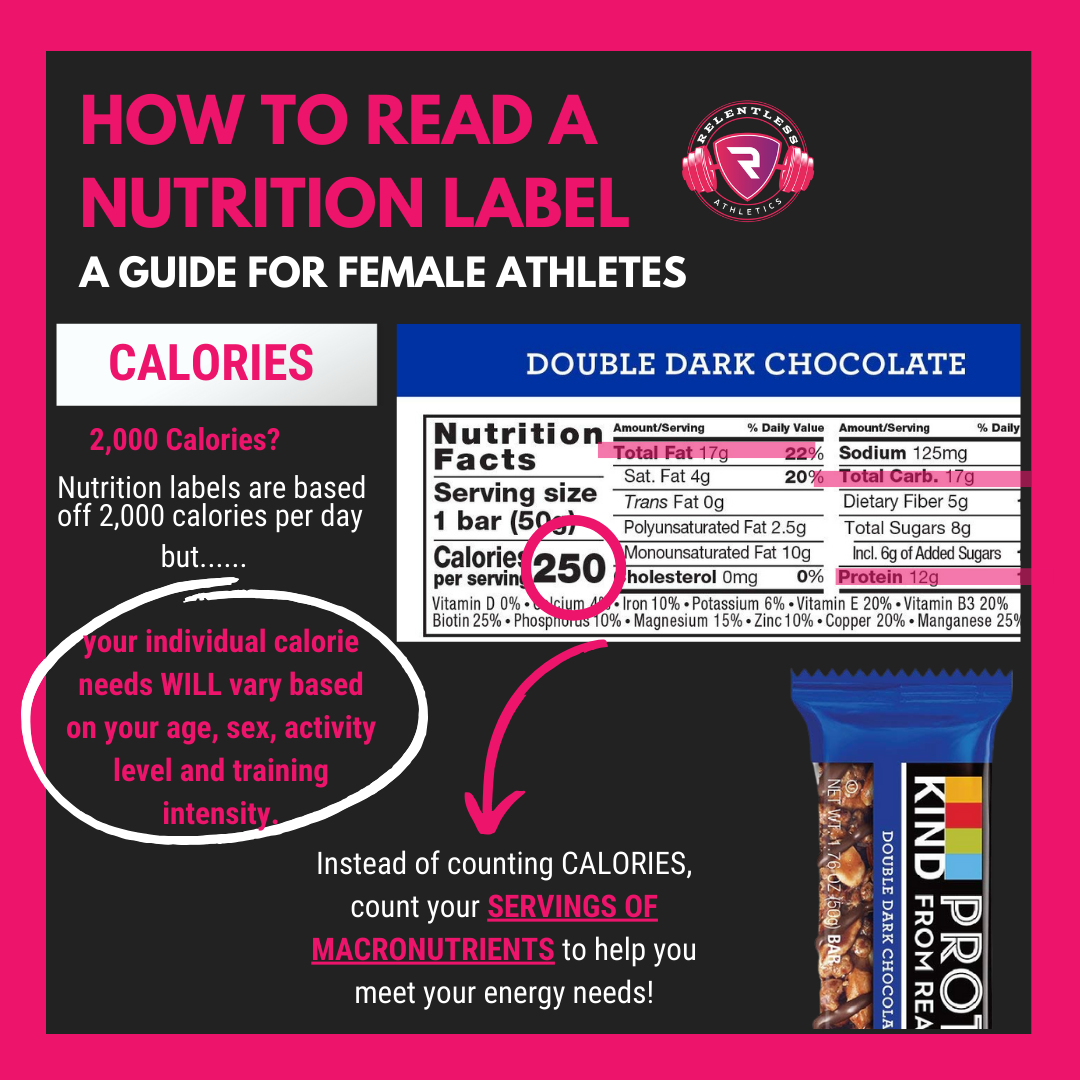Nutrition Labels: A Guide for Female Athletes to Making Informed Food Choices
By Emily Neff (Pappas), Ph.D. student
Nutrition labels are crucial in helping our athletes make informed decisions about the food they consume.
They provide a snapshot of the nutrients within a particular food, aiding individuals in maintaining a balanced and healthy diet.
However, it's essential to understand the nuances of these labels to utilize them effectively.
Keep reading to learn:
What serving sizes mean
The order in ingredient lists matters!
Understanding %Daily Value for Protein vs. Grams of Protein
What is the Nutrition Label?
Purpose
Nutrition labels are your go-to tool for quick insights into the nutritional content of the foods that fuel your daughter’s athletic endeavors.
While they provide valuable information, viewing them as a guide rather than a definitive measure of a food's overall quality is crucial.
Best Use
Use nutrition labels to make conscious choices that support your athlete’s performance and recovery.
Keep in mind that nutrient labels may have a margin of error of up to 20%, so use them as a tool, not an absolute.
SERVING SIZES 101
Understanding serving sizes is particularly relevant for active female athletes.
Serving sizes are based on the amount of food typically consumed at one time, and nutritional information is often based on one serving. Knowing this helps you plan your meals and snacks effectively to meet your energy needs.
Female athletes require more food than their sedentary counterparts.
Use serving sizes as a GUIDE, but make it fit YOUR athlete’s needs!
For instance, if your athlete typically eats only four meals per day but needs to eat 4-5 servings of protein, she may need MORE than one serving of Greek yogurt to meet her needs!
Check out this example for Chobani yogurt servings and a female athlete ~140lbs bodyweight:
NUTRIENT LIST
Included Nutrients
Pay attention to various nutrients, including total calories, calories from fat, total fat, saturated fat, cholesterol, sodium, total carbohydrates, dietary fiber, sugars (including added sugars), protein, vitamin A, vitamin C, calcium, and iron.
LOOK AT MACRONUTRIENTS FIRST!
Understand macronutrient servings to ensure a balanced diet that supports your athlete’s athletic performance.
Typical serving sizes for the female athlete:
Protein 1 serving = ~25g
Aim to eat as many grams of protein as her body weight in lbs to meet her performance and recovery needs = 4-6 servings of protein daily!
Carb 1 serving = ~25g
Aim to eat ~1.5-4x as many grams of carbohydrates as her body weight on active days = 8-13 servings of carbs daily!
Fat 1 serving = ~15g
Aim to eat about 1/3 to 1/5 as many grams of fat as her body weight = 3-4 servings of fats daily!
Not sure how this should be eaten in a day? Check out this article on nutrient timing!!
MICRONutrients to Prioritize & LIMIT
Focus on achieving 100% of the Daily Value (DV) for micronutrients like dietary fiber, iron, calcium, vitamin D, and potassium.
At the same time, aim to limit intake of saturated fat, sodium, trans fat, and added sugars to less than 100% DV.
CALORIES
What are calories
Calories are units of energy- and macronutrients are energy! Take the calorie count with a grain of salt, as some nutrient labels can be off by almost 20%!!!
Macronutrient Breakdown:
1g Protein= 4 calories
1g Carbs= 4 calories
1g Fats = 9 calories
While the general guideline suggests 2,000 calories per day, your individual calorie needs may vary based on your activity level and training intensity.
Caloric Guidelines- rule of thumb:
As a general rule of thumb (provided by the FDA), 100 calories per serving of an individual food is considered a moderate amount & 400 calories or more per serving of an individual food is considered high in calories
Instead of counting calories, it is more helpful to count MACRONUTRIENT SERVINGS as that will help you reach your caloric needs without you focusing on the nuances of calories.
% Daily Value (%DV)
What is it?
The grams of nutrients, such as protein, fat, or carbohydrates, may be identical between different food products.
However, the %DV considers the quality of the nutrients, offering a comparative measure that considers overall dietary needs.
Comparison Tool
Use %DV to compare food brands and select options higher in nutrients you need more of while being mindful of those you need less of.
Remember that 5% DV or less is considered low, while 20% DV or more is high.
The Key to Determining Protein Quality:
%DV offers insights into protein quality, ensuring you get the high-quality protein (with all the amino acids the body needs) necessary for optimal athletic performance.
Consider two products, both listing 20g of protein.
While the grams are the same, the %DV might differ.
Product A may have a higher %DV, indicating that it contributes significantly to your daily protein needs compared to Product B.
IngredientS List
Order Matters
Always read ingredient lists!
Checking out the ingredients helps you see WHERE the macronutrients come from
For example, If a protein bar says it is HIGH in protein but has a 10% DV, check the ingredients!
It may be because the protein is from a plant source which is lower in amino acids!
Ingredients are ordered from MOST to LEAST!
The ingredients you see first are listed because there are MORE of it than at the bottom of the list!
Putting it together
Understanding and interpreting nutrition labels tailored to the needs of female athletes is a powerful tool for optimizing your athletic performance.
By navigating serving sizes, nutrient lists, calories, %DV, and ingredient order, you can actively contribute to your overall health and success in your athlete’s chosen sport.
Interested in learning more? Check out these related articles:
Want more recipes? Check out our recipe book!
NOT SURE HOW MUCH TO EAT? CHECK OUT OUR NUTRITION TEMPLATES FOR FEMALE ATHLETES!
Interested in 1:1 Nutrition Coaching (both in-person and virtual)?
Check out our Nutrition Program
ABOUT THE AUTHOR
In 2015 Emily opened Relentless Athletics to build a community for female athletes while educating their parents and coaches on the necessity of strength training and sports nutrition to optimize sports performance and reduce injury risks in the female athlete population.
Emily holds a M.S. in Exercise Physiology from Temple University and a B.S. in Biological Sciences from Drexel University. She is currently pursuing her Ph.D. at Concordia University St. Paul with a research focus on female athletes & the relationship between strength training frequency, ACL injury rates, and menstrual cycle irregularities (RED-s). Through this education, Emily values her ability to coach athletes and develop strength coaches with a perspective that is grounded in biochemistry and human physiology.
When she isn’t on the coaching floor or working in her office, she is at home with her husband Jarrod and their daughter Maya Rose, and, of course, their dog Milo (who has become the mascot of Relentless)!!































